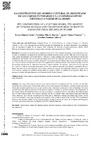Please use this identifier to cite or link to this item:
https://accedacris.ulpgc.es/jspui/handle/10553/72893
| DC Field | Value | Language |
|---|---|---|
| dc.contributor.author | Delgado Darias, Teresa | en_US |
| dc.contributor.author | Alberto Barroso, Carmen Verónica | en_US |
| dc.contributor.author | Velasco Vázquez, Francisco Javier | en_US |
| dc.contributor.author | Santana Cabrera, Jonathan Alberto | en_US |
| dc.date.accessioned | 2020-06-02T16:57:34Z | - |
| dc.date.available | 2020-06-02T16:57:34Z | - |
| dc.date.issued | 2017 | en_US |
| dc.identifier.issn | 2386-6837 | en_US |
| dc.identifier.other | Dialnet | - |
| dc.identifier.uri | https://accedacris.ulpgc.es/handle/10553/72893 | - |
| dc.description.abstract | Los modos de ataviarse para cualquier evento de la vida son parte del propio reconocimiento colectivo pues, en definitiva, no dejan de ser atributos que definen la esencia social del ser. Más allá de un criterio personal, posee un profundo significado étnico y cultural y, como cualquier acto social, representa un código consensuado de significados. En las recientes investigaciones sobre las prácticas funerarias de los antiguos canarios se identifica una serie de actos reglados, dirigidos a la preparación del difunto antes de su acomodación sepulcral, con un carácter estandarizado que afecta al conjunto de la población insular. Esta práctica incluye el uso de una mortaja funeraria que se elaboraba con pieles y tejidos vegetales. No obstante, como vehículo de expresión de lo que se es, han de existir diferencias que, en este caso, parecen concernir a la calidad y cantidad de los productos utilizados en el procedimiento. Este trabajo aborda ese aspecto del tratamiento funerario a partir de un caso concreto, tratando de establecer dónde radica lo común y dónde se establece la divergencia. Para ello se presenta el estudio del fardo funerario de la Momia 8 de El Museo Canario. | en_US |
| dc.description.abstract | The way of dressing for any life event express collective recognition itself and, in short, are attributes that define the social essence of being. Beyond a way of expressing personal identity, clothing display has a deep ethnic and cultural significance and, as any social action, represents a consensus code of meanings. In recent research about the funerary practices of the ancient canaries, a number of gestures related to the preparation of the corpses before the burial have been noticed, according to a standard protocol, that affects the entire population of Gran Canaria island. This practice includes the use of shrouds made with animal skins and vegetable fibers. However, as a vehicle of expression of what one is, differences among individuals and groups can be perceived, basically concerning the quality and quantity of the products used on the shrouds. This contribution addresses the funerary bundles of the ancient canaries, trying to determine where the common and divergence lie, from a particular study case: the Mummy 8 of The Canarian Museum. | en_US |
| dc.language | spa | en_US |
| dc.source | XXII Coloquio de Historia Canario-Americana [ISSN 2386-6837], v. 22(139). | en_US |
| dc.subject | 550405 Prehistoria | en_US |
| dc.subject.other | Gran Canaria | en_US |
| dc.subject.other | Etapa prehispánica | en_US |
| dc.subject.other | Prácticas funerarias | en_US |
| dc.subject.other | Preparación del cadáver | en_US |
| dc.subject.other | El Museo Canario | en_US |
| dc.subject.other | Momia 8 | en_US |
| dc.subject.other | Gran Canaria Island | en_US |
| dc.subject.other | Pre-hispanic period | en_US |
| dc.subject.other | Funerary practices | en_US |
| dc.subject.other | Corpse treatment, | en_US |
| dc.subject.other | The Canarian Museum | en_US |
| dc.subject.other | Mummy 8 | en_US |
| dc.title | La construcción del modelo cultural. El significado de los fardos funerarios y la conformación de identidad a partir de la momia | en_US |
| dc.title.alternative | The construction of a cultural model. The meaning of funeral bundles and the development of identity emanating from the idea of mummy | en_US |
| dc.type | info:eu-repo/semantics/conferenceObject | en_US |
| dc.type | conferenceObject | en_US |
| dc.relation.conference | XXII Coloquio de Historia Canario-Americana | en_US |
| dc.identifier.url | http://dialnet.unirioja.es/servlet/articulo?codigo=7360446 | - |
| dc.description.lastpage | 0 | en_US |
| dc.description.firstpage | 113 | en_US |
| dc.investigacion | Artes y Humanidades | en_US |
| dc.type2 | Actas de congresos | en_US |
| dc.contributor.authordialnetid | No ID | - |
| dc.contributor.authordialnetid | 740070 | - |
| dc.contributor.authordialnetid | 823237 | - |
| dc.contributor.authordialnetid | 2969060 | - |
| dc.identifier.dialnet | 7360446ARTLIB | - |
| dc.utils.revision | Sí | en_US |
| dc.identifier.ulpgc | Sí | es |
| dc.contributor.buulpgc | BU-HUM | en_US |
| item.fulltext | Con texto completo | - |
| item.grantfulltext | open | - |
| crisitem.event.eventsstartdate | 01-10-2016 | - |
| crisitem.event.eventsenddate | 31-10-2016 | - |
| crisitem.author.dept | GIR Investigación en Arqueología y Patrimonio | - |
| crisitem.author.dept | GIR Investigación en Arqueología y Patrimonio | - |
| crisitem.author.dept | GIR Investigación en Arqueología y Patrimonio | - |
| crisitem.author.dept | GIR Investigación en Arqueología y Patrimonio | - |
| crisitem.author.dept | Departamento de Ciencias Históricas | - |
| crisitem.author.orcid | 0000-0002-2709-5180 | - |
| crisitem.author.orcid | 0000-0003-0339-3500 | - |
| crisitem.author.orcid | 0000-0002-9615-8560 | - |
| crisitem.author.parentorg | Departamento de Ciencias Históricas | - |
| crisitem.author.parentorg | Departamento de Ciencias Históricas | - |
| crisitem.author.parentorg | Departamento de Ciencias Históricas | - |
| crisitem.author.parentorg | Departamento de Ciencias Históricas | - |
| crisitem.author.fullName | Delgado Darias, Teresa | - |
| crisitem.author.fullName | Alberto Barroso,Carmen Verónica | - |
| crisitem.author.fullName | Velazco Vázquez,Francisco Javier | - |
| crisitem.author.fullName | Santana Cabrera, Jonathan Alberto | - |
| Appears in Collections: | Actas de congresos | |
Items in accedaCRIS are protected by copyright, with all rights reserved, unless otherwise indicated.
